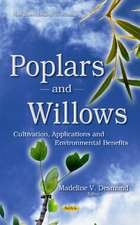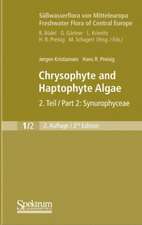Süßwasserflora von Mitteleuropa, Bd 19/1: Cyanoprokaryota: Chroococcales: Süßwasserflora von Mitteleuropa, cartea 19/1
Autor Jiří Komáreken Limba Engleză Paperback – 20 oct 2008
This book was written for identification and standardization of known, morphologically and ecologically distinguishable European Cyanoprokaryotes that have been described from natural populations. In the introductory part only data important for identification practice are therefore included. At the end of this chapter we append a list of this basic literature, which comprises all the necessary detailed information. We have selected accurate drawings of described species.
Din seria Süßwasserflora von Mitteleuropa
- 14%
 Preț: 611.24 lei
Preț: 611.24 lei - 14%
 Preț: 811.61 lei
Preț: 811.61 lei - 14%
 Preț: 858.61 lei
Preț: 858.61 lei - 14%
 Preț: 870.67 lei
Preț: 870.67 lei - 14%
 Preț: 913.76 lei
Preț: 913.76 lei - 11%
 Preț: 521.86 lei
Preț: 521.86 lei - 23%
 Preț: 945.32 lei
Preț: 945.32 lei - 23%
 Preț: 1490.64 lei
Preț: 1490.64 lei - 14%
 Preț: 919.14 lei
Preț: 919.14 lei - 18%
 Preț: 945.88 lei
Preț: 945.88 lei - 14%
 Preț: 1018.77 lei
Preț: 1018.77 lei - 14%
 Preț: 910.90 lei
Preț: 910.90 lei - 14%
 Preț: 674.12 lei
Preț: 674.12 lei - 15%
 Preț: 631.22 lei
Preț: 631.22 lei - 11%
 Preț: 532.99 lei
Preț: 532.99 lei - 14%
 Preț: 917.45 lei
Preț: 917.45 lei - 14%
 Preț: 550.80 lei
Preț: 550.80 lei - 19%
 Preț: 544.82 lei
Preț: 544.82 lei - 14%
 Preț: 891.48 lei
Preț: 891.48 lei - 23%
 Preț: 864.42 lei
Preț: 864.42 lei - 18%
 Preț: 957.75 lei
Preț: 957.75 lei
Preț: 931.77 lei
Preț vechi: 1210.09 lei
-23% Nou
178.29€ • 186.17$ • 147.23£
Carte tipărită la comandă
Livrare economică 11-17 aprilie
Specificații
ISBN-10: 382742111X
Pagini: 556
Ilustrații: VI, 548 p.
Dimensiuni: 127 x 190 x 29 mm
Greutate: 0.54 kg
Ediția:1. Aufl. 1998. Nachdruck 2008
Editura: Spektrum Akademischer Verlag
Colecția Spektrum Akademischer Verlag
Seria Süßwasserflora von Mitteleuropa
Locul publicării:Heidelberg, Germany
Public țintă
ResearchRecenzii
Notă biografică
The late Prof. Dr. Konstantinos Anagnostidis (formerly Institute of Systematic Botany, University of Athens, GREECE)
Prof. Dr. Jiri Komárek (Department of Algology, Institute of Botany, University at Trebon, CZECH REPUBLIC)
Textul de pe ultima copertă
Cyanoprokaryotes are probably the oldest organisms with plant metabolism. However, their cell structure and type of asexual reproduction prove their eubacterial origin. In spite of their existence from Precambrian onwards they have not lost their vitality, and still are able to colonize all possible biotopes, including very extreme environments (thermal springs up to 80 °C, rocks in extremely hot or cold deserts in both the tropics and Antarctica, hypersaline lakes and marshes, biotopes in volcanic regions, and other harsh habitats).
This book is a review of all the cyanoprokaryotic taxonomic units, registered and recognizable from European natural biotopes, including the marine coasts. Our determination keys and taxonomic descriptions should permit the identification of natural populations, and should be related to known culture material. Numerous strains were isolated, kept in strain collections and used as important model organisms for experiments of various kinds. Only a few Cyanoprokaryotes grow in culture in the typical form known from nature, the others usually need special procedures to induce their typical forms and life cycles. The identification of strains without previous knowledge of natural material needs to be studied with a special care.
This book was written for identification and standardization of known, morphologically and ecologically distinguishable European Cyanoprokaryotes that have been described from natural populations. In the introductory part only data important for identification practice are therefore included. At the end of this chapter we append a list of this basic literature, which comprises all the necessary detailed information. We have selected accurate drawings of described species. We also present illustrations of some non-European species when such figures are needed in order to understand the generic diacritical features or infrageneric diversity.
Caracteristici
In englischer Sprache
Erster Teil des Bd. 19 über Cyanokaryota, sehr urtümliche bakterienartige Organismen
Für die Abonnenten der Reihe, Limnologen und Spezialisten von großer Relevanz
Descriere
Cyanoprokaryotes are probably the oldest organisms with plant metabolism. However, their cell structure and type of asexual reproduction prove their eubacterial origin. They are able to colonize all possible biotopes, including very extreme environments (thermal springs up to 80 °C, rocks in extremely hot or cold deserts in both the tropics and Antarctica, hypersaline lakes and marshes, biotopes in volcanic regions, and other harsh habitats).
This book was written for identification and standardization of known, morphologically and ecologically distinguishable European Cyanoprokaryotes that have been described from natural populations. In the introductory part only data important for identification practice are therefore included. At the end of this chapter we append a list of this basic literature, which comprises all the necessary detailed information. We have selected accurate drawings of described species.


















